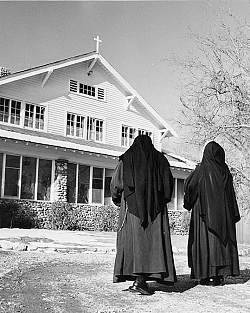Carmelites nuns have colorful history in Utah
Friday, May. 15, 2015

Intermountain Catholic
+ Enlarge
The original building on the grounds of the Carmel of the Immaculate Heart of Mary monastery in Holladay was considered unsafe; it was torn town and replaced with the existing convent. IC file photo
(Editor’s note: In recognition of the Year for Consecrated Life, this is one in a series of articles about the religious orders that have contributed to the faith in the Diocese of Salt Lake City.)
Could a group of roughly 12 women shut up within four walls saying prayers for over a half century even have a history? They sure can, and the Carmelite Sisters of Utah actually have a fairly colorful and even controversial one.
Although the Carmelite Order was founded in Palestine in 1154, its members claim a continuity with the hermits of Mount Carmel in ancient times and a mythical connection all the way back to the Prophet Elijah. We are concerned here, though, with the Discalced (“unshod”– they wear sandals) Carmelites, a reform branch created in mid-16th century Spain by Saints Teresa of Avila and John of the Cross. The reform was a reaction to the perceived laxity of the order at the time, and demanded a return to a very ascetic cloistered life of poverty, penance and prayer. As such, it was one of the spiritual centers of the Counter-Reformation.
The Most Rev. Duane G. Hunt, fifth Bishop of Salt Lake, who had successfully lured several religious orders to Utah, must have been surprised to receive a letter dated Feb. 1, 1949 from Carmelite nuns in Santa Clara, Calif. asking him if he would welcome a Carmelite foundation in the diocese. Negotiations proceeded apace, and in 1952 the first Carmelites purchased and moved into a house on Second South at about Tenth East. At that point another interesting twist emerged, for the nuns made the down payment on the house with $2,500 donated by Estelle Doheny.
Estelle Doheny? American history buffs will recognize her as the widow of wealthy Los Angeles oilman Edward L. Doheny, one of the principals in the infamous Teapot Dome bribery scandal of the early 1920s.
The connection between Estelle Doheny and Utah is this: The Diocese of Salt Lake’s second bishop, the Right Rev. Joseph Glass, while a priest in Los Angeles, had become virtually an adopted Doheny family member and had baptized Estelle. (Glass had no connection with the Teapot Dome affair, which broke years after he had come to Utah.) Records in the diocesan archives show that Bishop Glass invited Carmelite nuns from California to come to Utah in 1921, but they responded that their foundation was yet new (1916) and they felt they lacked the institutional maturity to be launching satellite houses. But Glass had obviously discussed the possibility of a subsidy from the Dohenys, and Mrs. Doheny came through, fully a quarter century after Glass’s death in 1926!
The house on Second South very quickly proved unsuitable for a Carmelite convent. Father William H. McDougall, chaplain for the Carmelites, submitted a devastating report to Bishop Hunt, centering on the cramped quarters allowing inadequate privacy and the lack, in that urban setting, of the quiet and seclusion necessary for a life of prayer. Eventually, in the 1960s, the nuns were able to acquire the property on Holladay Boulevard that they presently occupy. But even that, for all the advantages of its rural seclusion, presented daunting problems. For one thing, the building they attempted to occupy was in such ramshackle condition that it threatened to collapse. The septic tank was in such precarious shape that the nuns feared even to do laundry. Finally, a construction company was stealing water from the nuns’ share of Little Cottonwood Creek, risking a lawsuit against them from downstream users.
By this time, Bishop Joseph L. Federal had taken over the diocese. He was not in favor of the Carmelites’ plans for a new building; he also apparently distrusted their feisty Superior, Sister Marie Therese, who had her own ideas about architects, lawyers and financial managers.
A very testy series of letters ensued among the bishop, the Mother Superior, and even the Apostolic Delegate to the United States. Bishop Federal once went so far as to hire a private investigator to check on the man Sr. Marie Therese had hired to manage the finances, discovering that the fellow was a convicted embezzler! The fact that the facility eventually got constructed despite all those conflicts and contradictory personalities could be considered, without undue piety, as an act of God.
Despite its sometimes tumultuous history, the Carmel of the Immaculate Heart of Mary monastery in Holladay has been an incalculable blessing to the diocese, a fact gratefully acknowledged each year by the throngs who attend their annual Carmelite Fair fundraiser. “Incalculable” is the right word, for a life of prayer must of necessity be a life of patience, and the results of those prayers are fully known only to God.
For questions, comments or to report inaccuracies on the website, please CLICK HERE.
© Copyright 2024 The Diocese of Salt Lake City. All rights reserved.
© Copyright 2024 The Diocese of Salt Lake City. All rights reserved.

Stay Connected With Us